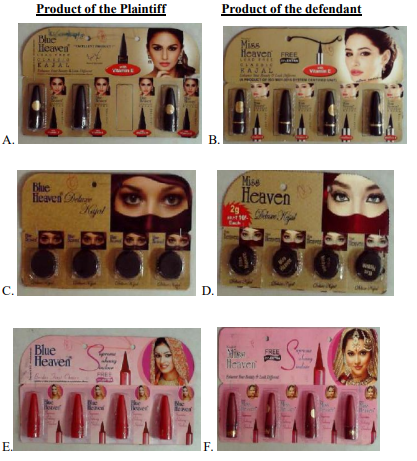Heinz Italia & Anr. v. Dabur India Ltd.
Heinz Italia & Anr. v. Dabur India Ltd.
(2007) 6 SCC 1
Facts of the case:
The Appellants, were the proprietor of the trademark “Glucon-D” which was registered in India under The Trade and Merchandise Marks Act, 1958.
The said trademark had earlier been registered by Glaxo Laboratories in 1975, but the same had been assigned to the Appellants in 1994 along with the goodwill and rights in the artistic work of packaging.
In July, 2002, Appellants found out that that respondent, Dabur India Ltd. (Respondent) had launched a similar product under the name “Glucose-D”, the packaging of which was deceptively similar to that of their product.
Appellants thereupon filed a suit for permanent injunction for infringement of the trademark and Copyright.
Appellants had also applied for the relief of ad-interim injunction to restrain the respondent from using the trademark “Glucose-D” or any other trademark having deceptively similar packaging till the disposal of the suit.
The trial court rejected the plea of the Appellants and consequently an appeal was made to the Punjab and Haryana High Court. The High Court confirmed the decision of the Trial Court and dismissed the appeal. Therefore, the Appellants filed the present appeal.
Arguments on behalf of Appellants:
• Respondent was trying to affect the goodwill and reputation which the trade mark “Glucon-D” and it’s packaging enjoyed in the market.
• Being a prior user is the cardinal test for cases of infringement and passing off. The mark “Glucon-D” was being used since 1940 by Glaxo and was registered in 1975, whereas the term “Glucose-D” has come into use since 1989.
• “Glucon-D” is not a generic word or expression and even if it is assumed that it is generic in nature, an injunction could still follow in special circumstances as held in Godfrey Philips India Ltd v. Girnar Food and Beverages (P) Ltd.
Arguments on behalf of Respondent:
• The plea of the Appellant towards interim injunction has been rejected twice by the Courts below. In light of Wander Ltd. And Anr. v. Antox India Pvt. Ltd.; 1990 Supp (1) SCC 727, the order of the High Court need not be interfered with.
• Suit had been filed after many years (in 2003) though the mark “Glucose-D” is being used since 1989.
• ‘Glucose’ was a generic expression of the product being sold and as such no monopoly could be claimed by the Appellants.
• There was absolutely no similarity between the Appellants’ product “Glucon-D” and Respondent’s product “Dabur Glucose-D” and that the packaging of the two were completely different from one another.
Court’s observations:
• From the facts of the case in Wander Ltd. & Anr. v. Antox India Pvt. Ltd., the ad-interim injunction had been held to be rightly refused as the opposite party had claimed and proved prior user on which the passing off action was based. In the present case, however, the fact that the “Glucon-D” and its distinctive packaging had been used by Glaxo since the year 1940 and thereafter by the Appellants long before it had been used by the Respondent is clear on record.
• We observe that the both Glucon-D and Glucose-D are items containing glucose and to us it appears that there is remarkable phonetic similarity in these two words.
• With regards to the packaging in dispute, the colour schemes of both the products as well as a happy family image on the package are almost identical. However, the Respondent contended that in case of “Glucose-D”, the family consisted of 4 members and in “Glucon-D”, the family consisted of 3 members. However, overall effect of the packaging should be seen. Hence, the Court is of the opinion that the packaging of Glucose-D and Glucon-D is so similar that it can easily confuse a purchaser.
• If it could be prima facie shown that there was a dishonest intention on the part of the defendant in passing off goods, an injunction should ordinarily follow and the mere delay in bringing the matter to Court was not a ground to defeat the case of the Plaintiff.
The Supreme Court thus set aside the order of the trial court and the order of the High Court, and therefore the appeal of the Appellant was allowed. It is pertinent to mention that no injunction was granted by the Hon’ble Supreme Court towards use of the word “Glucose-D” and the injunction was only limited to the packaging.
Author: Divyasha Mathur, ILS Law College, Pune
Editor’s Comments: The present case dealt with the products “Glucon-D” and “Glucose-D” and their respective packaging. The Appellant was using the mark “Glucon-D” and it’s packaging (through itself and through it’s predecessor) since 1940. The Respondent was using the mark “Glucose-D” since 1989 and the impugned ‘family’ packaging since 2000. The Hon’ble Supreme Court has restricted the Respondent only qua the packaging but has not restricted them qua the word “Glucose-D”. It is stated that the Hon’ble Court makes a passing observation that the marks are similar but does not provides any reason as to why it has not granted an injunction towards use of the mark “Glucose-D”. The Hon’ble Supreme Court might have been of the opinion that the term “Glucose” is descriptive or that there is a delay on part of the Appellant to approach the Hon’ble Court as the same was being used since 1989 whereas the impugned packaging was being used since 2000. However, no reasons are cited by the Hon’ble Court in this regard and only an injunction qua packaging is granted. If the Hon’ble Court was of the opinion that the marks are similar, then it should have given reasons why should Respondent’s product be allowed to operate in the market under the mark “Glucose-D” when admittedly, Appellant is the prior user of “Glucon-D” and “Glucose-D”.
It is not the Supreme Court’s reasoning that the Appellant has not asked for restraint order qua “Glucose-D”. However, despite the said prayer, the same has been denied while citing contrary reasons towards similarity and prior use.
The excellent part about the judgement is that it dilutes the whole jurisprudence set out in Wander Ltd. & Anr. v. Antox India Pvt. Ltd.; 1990 Supp (1) SCC 727, by distinguishing the facts in the two cases.
In our opinion, the marks products “Glucon-D” and “Glucose-D” are visually, structurally and phonetically similar. Glucose may be a descriptive term for Glucose based products. However, in such a case, Respondent should have used the word ‘Glucose’ alone. There was no need to add the letter ‘D’ to it in the similar manner as the Appellants. It is clear that the Respondent intended to come closer to the Appellant’s product and wanted to create an impression in the mind of the consumer that the Respondent’s product is a related product or a substitute for Appellants’ product. It cannot be disregarded that there is an massive chances of likelihood of confusion amongst the purchasing public. The confusion could be of trade origin, source, connection or association among the competing brands. In any event, the dictum of the Supreme Court holds the ground and the product bearing the mark “Glucose-D” continues to remain in the market but with a different packaging.




